
OCTOBER MEETING
| WEDNESDAY NIGHT
AT THE OPERA |
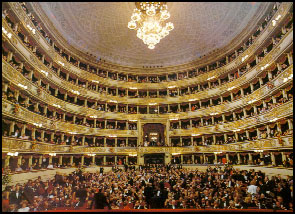
One of the most emblematic icons of Italian culture is opera
or opera lirica as known in Italy. Despite the undeniable
importance of the non-Italian repertoire, it seems that as soon as one
hears the word opera, the famous Italian works, composers, performers,
and arias spring immediately to mind in a near automatic reaction.
So our October program will be devoted to a closer look, and listen, to
this topic so dear to the hearts of most, if not all, Italians and Italian-Americans.
Our speaker will be club member, and unabashed opera enthusiast, Vito
Tamboli. But Vito gives us fair warning by saying that in this
presentation the topic may be treated, at least to some peoples’ way of
thinking, a bit irreverently, but always con amore and a sense of
fun.
In our October program we will listen to a famous aria (or part thereof)
from each of the four giants of Italian opera: Gioacchino Rossini
(Il Barbiere di Siviglia), Pietro Mascagni (Cavalleria Rusticana),
Giacomo Puccini, (Madama Butterfly), and Giuseppe Verdi (La Traviata).
In his presentation, Vito will discuss the history of each work and provide
a bit of information about the composers and some of the more famous performers.
Vito Tamboli is a retired business executive, a retired Colonel in the
US Army Reserve, and an adjunct professor at the SLU Business School.
In addition to being a frequent contributor to Il Pensiero, he makes
regular host appearances on the Italian Radio Show on Sunday afternoons.
Members may recall his last year’s presentation on the Battle of Monte
Cassino.
|
Next Meeting October 20
Cocktails 6:30 PM - Dinner 7:00 PM
Da Baldo's Restaurant

RECAP OF SEPTEMBER MEETING
| VICENZA, CITTÀ DEL PALLADIO |
At the September meeting, club member Luisa Gabbiani Flynn gave
an informative presentation on the topic Vicenza, città del Palladio,
her city of origin. She explained how Andrea della Gondola (1508-1580),
the son of a miller and a stonecarver, was called to work at a villa that
Count Giangiorgio Trissino was building on the outskirts of Vicenza and
from then on his life was changed: Trissino became his mentor and
and he became Palladio, one of the greatest architects of all times.
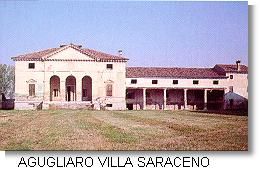
Palladio wrote the famous books I quattro libri dell’architettura,
in which he revolutionized western architecture of the 17th and 18th century
and produced the School of Architecture of the 19th century.
It was translated in every language and is still in print today.
His greatness is the result of his ability to arrive at universal principles
from the study of the past applied to contemporary needs. He did
not follow the trends of his days, but maintained his originality and became
the dominant figure in his field throughout his lifetime and the following
centuries until the present.
Palladio built villas, palaces and churches. All his churches
were built in central cities, especially Venice. All his palaces
and civic structures were built in Vicenza and other small towns of Veneto.
The Venetians were probably more alert than the mainlanders to signs of
financial instability and did not start any palaces after 1560. On
the contrary, Palladio’s patrons wanted their homes to be a public affirmation
of their wealth and status and most of them managed to finish the façade
and entranceway, but in the majority of the cases did not have the means
to complete them.
Palladio’s first and best known public commission was La Basilica,
the great meeting hall of Vicenza’s Council of the Four Hundreds.
The magnificent building dominates La Piazza dei Signori, where
he also built La Loggia del Capitaniato. Other important palaces
by Palladio adorning the streets of Vicenza are Palazzo Thiene, Palazzo
Chiericati, Palazzo Iseppo da Porto, Palazzo Barbaran da Porto, and
Palazzo
Valmarana. The Teatro Olimpico was designed by Palladio
but completed after his death by Vincenzo Scamozzi, who took great liberties
with the original plan. Palladio, however, is probably best known
for the ville he built on the Veneto countryside.
By this time the great maritime power of Venice had been affected by
three major events: the capture of Costantinople by the Turks in
1453; the discovery of the New World in 1492; and the discovery of a new
sea route around the southern tip of Africa by Vasco de Gama in 1497.
As a result, the wealthy merchants of Venice seeking more stable investments
began to acquire properties on the mainland. Palladio saw the need
and came up with the solution, designing the type of buildings that were
grandiose and economical, that could house in one complex the residence
of the landlord and storage for the animals, the harvest, and the tools.
The result are the ville, which in later centuries would be adopted
by the British squires and the American plantation owners, country gentry
who had social situations and needs nearly identical to their predecessors
in the Veneto.
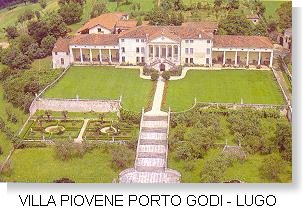
|

L'angolo del presidente
by Gene Mariani
ELECTION OF DIRECTOR
TO BE HELD AT NOVEMBER MEETING |
The Board of Directors of the Italian Club consists of four officers
and three directors. Elections for officers are held every two years whereas
an election for a director is held every year. This year the Director
election will be at the November meeting.
The director will be elected for a three-year term commencing at the
January 2000 meeting. Interestingly, he or she would be the first
Board Member elected to office in the new millennium. At the September
Board meeting, the President appointed a Nominating Committee responsible
for conducting the election and for preparing a list of members who wish
to be candidates for the position.
The names will be announced to the membership at the October meeting,
with the elections taking place at the November meeting. In addition,
candidates can be nominated from the floor at the time of the election
in November. The Nominating Committee consists of the following members:
Marie Wehrle, Chair (644-1645); Carolyn Stelzer (772-3355);
Nick
Mazzola (481-6508); Norman Merlotti (644-4068), and
Judy
Ronzio (772-8380). Any member interested in becoming a Club director
should inform a Nominating Committee member as soon as possible.
An explanation is due concerning the fact that this election will be
held in November rather than in October as specified in our by-laws:
we failed to notify our members in time, therefore, in order to give adequate
notification, the Board has decided to hold the election in November rather
than in October. In the future, elections will be in October. |
|
|
|
| |

ITALIAN COMMUNITY ACTIVITIES
| September 25 to October 23: Festa d’Italia at Niemann-Marcus
(as previously announced). A Celebration of Italian Culture in cooperation
with the Federation of Italian-American Organizations Italian Marketplace.
Tastes from Italian Restaurants, Markets, and Bakeries. At Frontenac
Plaza. For more information contact Gene Mariani (352-5484)
Sunday, October 3: Columbus Day Corporation’s Annual Recognition
Banquet will be held at Orlando’s Garden on Watson Road. Price
is $20/person. For tickets or more information, contact Marianne
Peri-Sack (837-8830)
Sunday, October 10: The annual Columbus Day Celebration
will be held in Berra Park. Festivities begin with a Parade starting
at 12:00 PM from Southwest Bank. The parade will wind its way through
the Hill neighborhood to Berra Park for the Columbus Day festival.
As we do every year, the Italian Club will participate with a booth.
We could use some help with the booth. If you are willing to work
with us for an hour or two that afternoon, we would greatly appreciate
it. Please call Gene Mariani (352-5484) or Carolyn Stelzer (772-3355).
Tuesday, October 12: Wreath-laying ceremony at Columbus Statue
in Tower Grove Park by the Federation of Italian-American Organizations
at 10:30 AM. For more information contact Gene Mariani (352-5484).
Sunday, October 24: Misericordia Society’s 79th Anniversary
Dinner Dance. A Tribute to the Italian Churches. The occasion
will also serve as reunion for members of the former St. Charles Borromeo
and Our Lady Help of Christian Parishes and for St. Ambrose Parish and
will give special recognition to Rev. Msgr. Adrian Dwyer, Rev. Msgr.
Salvatore Polizzi, Sister Felicetta Cola, and Sister Bridget Esposito.
At Carpenters Hall. Price $30 per person. For more information
contact Marianne Peri-Sack (837-8830)
|
|

SALVATORE SUTERA
RECEIVES MARCONI AWARD
Congratulations to Italian Club member, Salvatore Sutera, Ph.D.,
Spencer T. Olin Professor of Mechanical Engineering at Washington University
on being awarded the Unico National 1999 Guglielmo Marconi Award for Excellence
in Science and Engineering. The presentation ceremony and dinner
were held Saturday, September 25 at the Adams Mark Hotel in St. Louis.
|
|

ANNUAL TRIBUTE TO COLUMBUS
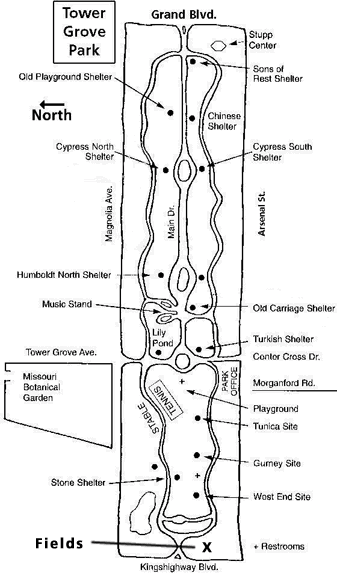
Henry Shaw, founder of Tower Grove Park (TGP) and great admirer of
Christopher Columbus, at his personal expense commissioned the Munich sculptor
Ferdinand Von Miller to create the monumental and famous statue of Columbus
located in the Park. The statue is among the first large cast bronzes
in the United States and the only one showing the great explorer with a
beard – a story in itself.
John Karel, TGP Director, after his recent Italian Club presentation
on Italianate design influences in the Park mentioned that every October
12 (the actual Columbus Day) a memorial wreath is laid at the statue in
honor of Columbus and as a sign of respect for Shaw, the Park’s great benefactor.
John also commented, in passing, that no Italian-American community organization
was represented at this ceremony.
At this year’s ceremony, the Italian-American community will be well
represented indeed. Joseph Colagiovanni, Honorary Vice Consul
of Italy, as representative of the Italian Government, will be present
and so will Vincent Garozzo, President of the Federation of Italian
American Organizations, Cav. Antonino Lombardo, publisher of Il
Pensiero newspaper, and other representatives of various Italian organizations.
In addition, through the efforts of Joseph Torrisi, children
from the Dewey International School, Shaw School, and possibly St. Ambrose
will attend the ceremony, as well as delegations from the Italian Community
Band and the Knights of Columbus. In addition to the wreath laying
ceremony, a tree will be planted by TGP in honor of Columbus. Incidentally,
all of the above named individuals are members of the Italian Club.
The ceremony will be held at 10:30 AM, Tuesday, October 12. The
Columbus Statue is located near the Grand Avenue entrance to the Park.
Members are urged to attend. The ceremony will take about 30 minutes
. |
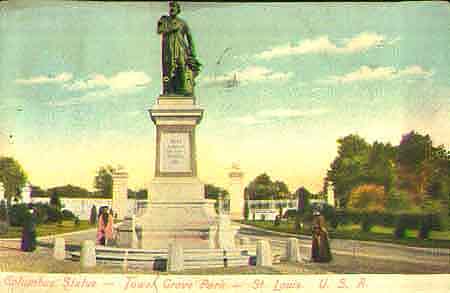
|


I capolavori della poesia italiana
14. Giovanni Della Casa (Mugello, Firenze, 1503 - Montepulciano,
Siena, 1556) è ricordato principalmente per il Galateo.
Fu uomo di chiesa e come tale ricoprì alti incarichi: commissario,
nunzio apostolico e arcivescovo.
Le Rime, la raccolta dei suoi componimenti lirici, vennero
pubblicate postume nel 1558 a sua richiesta. In questo sonetto il
poeta invoca il sonno, figlio della notte, perché lo liberi
dal dolore e dalle sofferenze.
O sonno, o de la queta, umida, ombrosa
di Giovanni Della Casa
-
O sonno, o de la queta, umida, ombrosa
-
notte placido figlio; o de’ mortali
-
egri1 conforto, oblio dolce de’ mali
-
sì gravi ond’è la vita aspra e noiosa2;
-
soccorri al core ormai, che langue e posa
-
non have, e queste membra stanche e frali3
-
solleva: a me ten vola, o sonno, e l’ali
-
tue brune sovra me distendi e posa.
-
Ov’è ’l silenzio che ’l dì fugge e’l lume4?
-
e i lievi sogni, che con non secure
-
vestigia5 di seguirti han per costume?
-
Lasso, che ’nvan te chiamo, e queste oscure
-
e gelide ombre invan lusingo. O piume6
-
d’asprezza colme! O notti acerbe e dure!
1dolenti. 2dolorosa.
3deboli. 4che
fugge il giorno e la luce. 5con passi non
sicuri. 6letto.
|
|
|

LA STORIA D’ITALIA
4. I Greci. Tra i primi a sistemarsi sulle
coste italiane furono gli Achei, di origine Dorica, che fondarono
Taranto, Metaponto, Posidonia (Paestum) e Sibari. Dopo di loro arrivarono
i Locri e i Calcedoni da Euboea, che fondarono Naxos (Taormina),
Zancle (Messina), Pitecusa (Ischia), e Cuma in Campania. I Corinzi
fondarono Siracusa, i Megari Megara Iblea nel golfo di Augusta,
e i Foci Elea (Velia) in Campania.
Il complesso delle colonie fondate da questi popoli greci nell’Italia
meridionale e nella Sicilia fu chiamato Magna Grecia. Le più
importanti furorno Cuma, Reggio, Napoli Siracusa, Agrigento, Sibari, Crotone,
Metaponto e Taranto. I loro abitanti si chiamarono Italioti e Sicelioti.
La civiltà della Magna Grecia fu il tramite tra la cultura greco-ellenistica
e l’Italia prima che Roma conquistasse la Grecia. L’architettura
della Magna Grecia è caratterizzata da monumentalità e predilezione
per lo stile dorico, come si vede nei tempi di Paestum. Notevole
è pure la produzione di rivestimenti fittili (di argilla) policromi,
di tavolette votive, di statuette in terracotta o in calcare e di sculture
in bronzo. Molto interessante è pure la produzione ceramica
con caratteristiche stilistiche e figurative diverse da quelle delle regioni
limitrofe.
Durante la prima metà del primo millenio A.C., nell’Italia del
nord cominciò la penetrazione dei Galli, popolazioni di origine
celtica che attraversarono le Alpi e occuparono gradualmente l’intera valle
del Po, mentre sulle coste tirrene dell’Italia centrale, nelle regioni
della Toscana e del Lazio settentrionale si insediarono gli Etruschi.
Gli Etruschi. Il primo storico che accenna agli
Etruschi è Erodoto, nel V secolo A.C. In una pagina delle
sue Storie egli allude alla loro origine orientale, confermata più
tardi anche dallo storico Ellanico. Ma già nel I mo
secolo A.C sorse una seconda tesi, secondo la quale le origini etniche
di questa popolazione sarebbero da ricercarsi nell’immenso crogiolo di
razze e di popoli della preistoria italiana, il che è comprovato
anche da studi recenti. Poiché erano una grande potenza marinara
ed ebbero relazioni con tutti i grandi paesi del Mediterraneo, nell’elaborazione
della loro civiltà gli Etruschi assimilarono elementi diversi, tra
cui italici, siro-egizi e greci. Politicamente erano organizzati
in città-stato (lucomonie) riunite in una confederazione a carattere
prevalentemente religioso comprendente dodoci città: Volterra,
Arezzo, Perugia, Cortona, Chiusi, Volsini, Populonia, Vetulonia, Vulci,
Veio, Cere e Tarquinia. Il potere era detenuto per diritto ereditario
dagli aristocratici. Gli Etruschi bonificarono la Maremma, svilupparono
una fiorente industria e attivissimi commerci. Appresa dai Fenici
e dai Greci l’arte della navigazione, spartirono con i Cartaginesi il dominio
del Tirreno. Nel periodo della loro maggiore potenza raggiunsero
a nord la pianura padana, ove fondarono Felsina (Bologna), Marzabotto,
Adria, e il porto di Spina; a sud conquistarono Roma, spingendosi fino
al golfo di Salerno dove incontrarono la resistenza dei Sabini e dei Greci.
(Continua al prossimo numero.)
|

ITALIANO PER PIACERE
 La seconda riunione
di Italiano per piacere si è svolta al ristorante Da Baldo
il primo settembre scorso con un programma molto piacevole. Dopo
l’introduzione di Franco Giannotti, Gianfranco Garganigo
ha parlato dei vini italiani dandocene il suo apprezzamento da buon intenditore
ed esperto. La serata si è conclusa con la poesia di Salvatore
Quasimodo Ed è subito sera recitata da Luisa Gabbiani
Flynn. L’ottima a cena, come sempre preparata con cura dai coniugi
Gandolfo,
ha contribuito al successo della serata. Amici italiani, arrivederci
al primo dicembre, dove ci aspetta un altro programma di qualità. La seconda riunione
di Italiano per piacere si è svolta al ristorante Da Baldo
il primo settembre scorso con un programma molto piacevole. Dopo
l’introduzione di Franco Giannotti, Gianfranco Garganigo
ha parlato dei vini italiani dandocene il suo apprezzamento da buon intenditore
ed esperto. La serata si è conclusa con la poesia di Salvatore
Quasimodo Ed è subito sera recitata da Luisa Gabbiani
Flynn. L’ottima a cena, come sempre preparata con cura dai coniugi
Gandolfo,
ha contribuito al successo della serata. Amici italiani, arrivederci
al primo dicembre, dove ci aspetta un altro programma di qualità. |
|

|